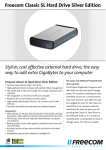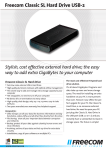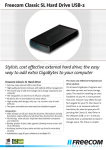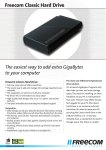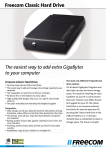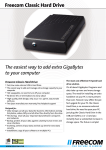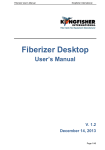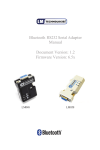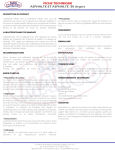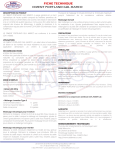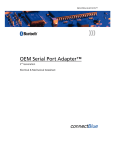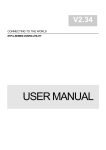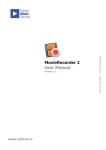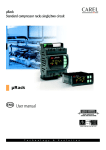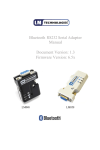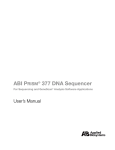Download iLOGPlus Manual
Transcript
iLOGPlus Internet enabled RTU/data logger User guide ILOGPLUS Internet enabled RTU/data logger User guide This manual refers to three variants of the iLOGPlusPlus RTU/data logger: 1. iLOGPlusPlus-LAN: 10BaseT Ethernet port. 2. iLOGPlusPlus-EDM: Serial port for external dial-up or wireless modems. 3. iLOGPlusPlus-GSM: Internal EGSM/GPRS modem (900/1800 MHz or 850/1900 MHz) Manual version: 1.3, 7/2009 Product versions: Hardware: 4.1, Firmware: 4.2 Disclaimer • While every effort has been made to ensure that the information in this guide is accurate and complete, no liability can be accepted for any errors or ommissions. • Infinite Ltd reserves the right to change the specifications of the hardware and software described in this guide at any time without prior notice. • No part of this guide may be reproduced, transmitted, stored in fixed or removable media or translated into any language in any form without the prior written permission of Infinite Ltd. • Infinite makes no warranties for damages resulting from corrupted or lost data due to malfunction of the hardware or the software. Copyright © 2005 - 2008 – Infinite Ltd All rights reserved. ILOGPlus RTU/data logger, User guide V1.0, 2/2008 2 Contents 1. Introduction 5 1.1 System block diagram 1.2 iLOGPlusPlus units 1.3 Technical characteristics 1.3.1 Absolute maximum ratings 1.3.1 Measurement section 1.3.2 Communication 2. Installation 12 2.1 Mounting 2.2 Wiring using the SCT-04E adaptor 2.2.1 Power supply 2.2.2 Analog inputs 2.2.3 Digital inputs 2.2.4 Digital outputs 2.3 Internet communications interface 2.3.1 10BaseT Ethernet port (iLOGPlus-LAN) 2.3.2 Modem port (iLOGPlus-EDM) 2.3.3 GSM antenna (iLOGPlus-GSM) 2.4 Connecting to a host computer 2.5 Connecting a GSM modem 2.6 Quick setup 2.6 Power on 3. Setup 25 3.1 Entering the menus 3.2 Unit identity 3.2.1 Unit name 3.2.2 Unit description 3.3 Logging parameters 3.3.1 Logging mode 3.3.2 Channel selection 3.3.3 Logging value selection 3.3.4 Logging rate 3.4 Measurement 3.4.1 Analog channels 3.4.2 Pulse counting channels 3.4.3 Digital inputs 3.5 Alarm parameters 3.5.1 Alarm mode 3.5.2 Prealarm limit 3.5.3 Alarm deadband 3.5.4 Alarm delay (Analog channels) 3.5.4 Alarm delay (Digital inputs) 3.6 Communication 3.6.1 Send rate 3.6.2 FIFO send mode 3.6.3 Data send mode 3.6.4 Alarm send mode 3.6.5 TCP/IP parameters 3.6.6 Email parameters 3.6.7 FTP parameters 3.6.8 GSM parameters 3.6.9 Send time synchronisation ILOGPlus RTU/data logger, User guide V1.0, 2/2008 3 3.6.10 Internet connect 3.6.11 Power save 3.6.12 Serial port configuration 3.7 Web page 3.7.1 Web page password 3.8 Digital outputs 3.9 Decimal separator 4. General settings and commissioning 60 4.1 Setting date and time 4.2 Starting the web server 4.3 Clear FIFO 4.4 Clear alarm log 4.5 Clear event log 4.6 Clear counter 4.7 Counter preset 4.8 Factory settings 4.9 Firmware upgrade 5. Operation 66 5.1 Main screen & key functions 5.2 Diagnostics 5.2.1 Testing communication 5.2.2 Viewing I/O values and states 5.2.3 Viewing the totalizer values 5.2.4 Viewing the logged data 5.2.5 Viewing the alarm log 5.2.6 Viewing the event log 5.2.7 Viewing the IP address 5.3 Connecting to a PC 5.3.1 Uploading data 5.4 Hardware test procedures 5.5 Remote control 5.5.1 TCP commands 5.5.2 SMS commands 6. Specifications 79 7. Troubleshooting 83 8. Appendix 84 8.1 Data transfer formats 8.1.1 File name 8.1.2 File format 8.1.3 Alarm annunciation 8.2 Parameter default values 8.3 Analog measurements 8.3.1 Signal conditioning circuits 8.3.2 Applications 8.4 TCP & SMS commands 8.4.1 Viewing system parameters 8.4.2 Commissioning commands 8.5 Firmware upgrade procedure 8.6 Communication errors 8.7 iLOGPlus EDM: Connectors layout 8.8 Internal web page 8.9 RS232 connector pin layout (COM2, SCT-04E-x) 8.10 Wiring the I/O expansion modules ILOGPlus RTU/data logger, User guide V1.0, 2/2008 4 1. Introduction 1.1. System block diagram Figure 1.1, Block diagram ILOGPlus RTU/data logger, User guide V1.0, 2/2008 5 1.2 iLOGPlus units iLOGPlus is a powerful RTU/data logger with full internet connectivity. Areas of application are telemetry and factory data acquisition. The main unit is equipped with 4 high resolution analog inputs, 4 digital inputs and 2 digital outputs. I/O can be expanded to 16 analog inputs, 16 digital inputs and 8 digital outputs using DIN-rail mount I/O expansion modules. Measurement data is stored in a FIFO structured power fail safe memory. The device is equipped with an LCD display and a membrane keyboard to facilitate data display and on site commissioning. ILOGPLUS is available in three variants, differing in the physical Internet communication interface: 1. iLOGPlus-LAN: 10BaseT Ethernet port. 2. iLOGPlus-EDM: Serial port for external dial-up or wireless modems. 3. iLOGPlus-GSM: Internal EGSM/GPRS modem (900/1800 MHz or 850/1900 MHz) Ethernet port (10BaseT) IRDA interface (optional) 4 line x 20 character display with backlight 15 key membrane keyboard Power supply, COM2 & signal connections Figure 1.2, ILOGPLUS-LAN unit ILOGPlus RTU/data logger, User guide V1.0, 2/2008 6 Modem port External modem supply control 4 line x 20 character display with backlight 15 key membrane keyboard Power supply, COM2 & signal connections Figure 1.3, ILOGPLUS-EDM unit ILOGPlus RTU/data logger, User guide V1.0, 2/2008 7 GSM antenna SIM card drawer GSM modem state LED 4 line x 20 character display with backlight 15 key membrane keyboard Power supply, COM2 & signal connections Figure 1.4, iLOGPlus-GSM unit ILOGPlus RTU/data logger, User guide V1.0, 2/2008 8 1.3 Technical characteristics 1.3.1 Absolute maximum ratings General conditions Analog input signal Recommended operation conditions Maximum rating A+ to A- (Differential voltage, signal floating, no GND reference) 0 – 1V -10V … +10V A- to GND (Signal floating, common mode voltage) inexistent or 0V -10V … +10V A+ to GND (A- connected to GND) 0 – 1V -10V … +10V iLOGPlus + SCT-04E-12 Signal Power supply voltage Vcc 0-20/4-20mA range 0-1V range Digital inputs Digital outputs (relay) Normal range 12V … 15 VDC 0-20mA 0-1V GND / open 12-60V DC, 0.5A, 12V-250V AC, 5A Maximum rating 18VDC -70mA …. +70 mA -10V …+10V -30V … +30V 110V DC, 0.5 250V AC1, 10A Normal range 24 … 28 VDC 0-20mA 0-1V GND / open 12-60V DC, 0.5A, 12V-250V AC, 5A Maximum rating 30 VDC -70mA …. +70 mA -10V …+10V -30V … +30V 110V DC, 0.5A 250V AC1, 10A iLOGPlus + SCT-04E-24 Signal Power supply voltage Vcc 0-20/4-20mA range 0-1V range Digital inputs Digital outputs (relay) Stresses above those listed under Absolute Maximum Ratings may cause permanent damage to the device. Exposure to absolute maximum rating conditions for extended periods may affect device reliability. Only one absolute maximum rating may be applied at any one time. ILOGPlus RTU/data logger, User guide V1.0, 2/2008 9 1.3.2 Measurement section iLOGPlus features 4 analog inputs (Channel 1-4) with 12 bit resolution. A variety of signal ranges is supported in conjunction with the SCT-04E adaptor. iLOGPlus features an internal signal conditioning circuit with switchable gain for channels 1, 2 and a 12 bit A/D converter. The A/D converter has an output range of 0-4096 corresponding to an 0-4096 mV input range (See Appendix xx for details). The following table contains typical signal ranges and sensor types for each analog channel. Channel Gain Low Low 1, 2 Low High Low Low 3, 4 Low Low Low Low Sensor RTD AD592*) AD590*) AD592*) AD590*) Physical range Resolution 0-1V 0.255 mV/bit 0 - 20 mA 5.11 µA/bit 4 - 20 mA 5.11 µA/bit -100..600°C 0.081 Ω/bit -25..105°C 0.094 °C/bit -55..110°C 0.094 °C/bit 0-1V 0.255 mV/bit 0 - 20 mA 5.11 µA/bit 4 - 20 mA 5.11 µA/bit -25..105°C 0.094 °C/bit -55..110°C 0.094 °C/bit Table 1 *) AD592, AD590 are popular, linear temperature sensors (Analog Devices). The following table contains typical signal ranges and sensor types for each analog channel of the analog input expansion module GE-AI-4 (AIx1- AIx4). Channel Sensor 1, 2, 3, 4 RTD Physical range Resolution 0-1V 0.255 mV/bit 0 - 20 mA 5.11 µA/bit 4 - 20 mA 5.11 µA/bit -100..600°C 0.157 Ω/bit Digital inputs (D1-4) have several functions: 1. The input signal state can be used as condition for logging the corresponding analog channel (1-4). 2. They can act as common inputs for monitoring and logging digital signals. 3. Input 3, 4 can be configured as counter inputs with following functions: • Totalizer function with preset and clear. • Frequency measurement with two range options (0-32.000Hz and 03200.0 Hz). The frequency measurements can be logged as virtual analog channels 5 and 6. ILOGPlus RTU/data logger, User guide V1.0, 2/2008 10 Digital inputs of the GE-DIO-modules 42 (Dx1-x4) have following functions: 1. The input signal state can be used as condition for logging the corresponding analog channel (1-4). 2. They can act as common inputs for monitoring and logging digital signals. Digital outputs (DO 1-2) can have two functions: 1. Prealarm and alarm monitoring. 2. Remote controlled digital outputs. Digital outputs of the GE-DIO-modules 42 (DO x1-x2) can have only one function: 1. Remote controlled digital outputs. 1.3.3 Communication iLOGPlus-LAN features a 10BaseT Ethernet port (COM1) and an auxilliary serial port (COM2). iLOGPlus-EDM features a main serial port (Modem port, COM1) and an auxilliary serial port (COM2). iLOGPlus-GSM has an internal GSM/GPRS modem (COM1) and an auxilliary serial port (COM2). All units support TCP/IP connectivity with following transfer capabilities: 1. FTP file transfer of the logged data. 2. Sending email with attachement of the logged data. 3. Sending email on alarm events. 4. Publishing the internal web server for observing real time measurements and changing parameters using a web browser. 5. Sending SMS on alarm events (iLOGPlus-GSM, iLOGPlus-LAN, EDM with external wireless modem). 6. Receiving SMS commands and answering with SMS containing measurement data and parameter values. Both fixed IP and dynamic IP connections are supported from all units. The auxilliary serial port (all units) can be used for the following purposes: 1. Uploading the logged data to a host computer using the XMODEM protocol. 2. Alarm annunciation via SMS using an external GSM modem (iLOGPlusLAN). 3. Firmware upgrade of the unit. The serial port has no Internet support. The local serial connection functionality is internally switchable between the RS232 port and the optional infared port, if the unit incorporates the irDA option. ILOGPlus RTU/data logger, User guide V1.0, 2/2008 11 2. Installation 2.1 Mounting A wall suspension element with snap in lock is used to mount the unit. 2.2 Wiring using the SCT-04E-xx adaptor Adaptor SCT-04E snaps on a DIN rail. Digital inputs 1-4 RRS232 port (COM2) Digital Outputs 1, 2 I/O expansion port Jumper for supplying I/O expansion units over the SCT-04E. Jumpered: Internal supply Open: External supply 25 pin FCC to iLOGPlus 1A Fuse Analog input conficuration jumpers Analog input connections 1-4 Power supply connection The 25 pin D-plug to the iLOGPlus unit is not hot pluggable! Plugging or unplugging this connector, during power up, can stress the sensitive analog circuits of the device and lead to permanent hardware failure! ILOGPlus RTU/data logger, User guide V1.0, 2/2008 12 2.2.1 Power supply Jumper 14 for internal expansion module 12/24/V supply - + SCT-04-12: 12-15V DC SCT-04-24: 24-27V DC Put a jumper on ‘Jumper 14’ to supply expansion modules from the internal 12/24V power supply. The communications section of the device is always in power on state in case of iLOGPlus LAN (Default settings: Internet connect parameter = on). iLOGPlus-GSM and iLOGPlus-EDM start with the communications section in power off state (Default settings: Internet connect parameter = off). Power supply requirements (Typical ratings) SCT-04E-12, at 12VDC Operation state Normal operation (logging) Display Backlight = off Power save param = ON Normal operation (logging) Display Backlight = off Power save param = OFF Internet connection Display Backlight = off Setup Display Backlight = on iLOGPlusLAN 95 mA iLOGPlus-GSM 50 mA iLOGPlusEDM *) 50 mA 95 mA 100 mA 80 mA 95 mA 200 mA (2A peak) 120mA 80 mA 130 mA 120mA Display backlight current draw: ~40 mA *) Without external modem iLOGPlus-GSM can draw up to 2A, in short periods (bursts) during data transmission. A power supply with current limitation under 2A is not suitable for proper device operation. ILOGPlus RTU/data logger, User guide V1.0, 2/2008 13 2.2.2 Analog inputs Main unit analog inputs 1, 2: Connecting 0-1V: Inproper jumper settings can damage the signal source and/or the SCT-04E input current sense resistors! (See Appendix 8.3) Connecting 0-20mA, 4-20mA: Connecting an RTD sensor: ILOGPlus RTU/data logger, User guide V1.0, 2/2008 14 Connecting a AD592 sensor: Main unit analog inputs 3, 4: Connecting 0-1V: Connecting 0-20mA, 4-20mA: Connecting a AD592 sensor: ILOGPlus RTU/data logger, User guide V1.0, 2/2008 15 GE-AI-4 analog inputs 1, 2, 3, 4: Connecting 0-1V: Connecting 0-20mA, 4-20mA: Connecting an RTD sensor: ILOGPlus RTU/data logger, User guide V1.0, 2/2008 16 Connecting a AD592 sensor: Digital inputs (Main unit & GE-DIO-42) Main unit digital outputs In case of DC power supply and inductive loads, use a freewheel diode parallel to the load. ILOGPlus RTU/data logger, User guide V1.0, 2/2008 17 GE-DIO-42 digital outputs 2.3 I/O Expansion iLOGPlus main unit accepts I/O expansion by means of analog and digital I/O modules on a serial bus. Analog input module GE-AI4 containing 4 analog inputs can be applied for analog input expansion. GE-DIO-4 digital I/O module containing 4 digital inputs and 2 digital outputs can be used for digital I/O expansion. The serial expansion bus plugs on the SCT-04E expansion connector (6 pin modular connector). Following I/O are recognized by the iLOGPlus CPU according to the modules DIP switch settings: Analog IN expansion No.1: AI 11 – AI 14 Analog IN expansion No.2: AI 21 – AI 24 Analog IN expansion No.3: AI 31 – AI 34 ILOGPlus RTU/data logger, User guide V1.0, 2/2008 18 Digital IN expansion No.1: Digital IN expansion No.2: Digital IN expansion No.3: DI 11 – DI 14 DI 21 – DI 24 DI 31 – DI 34 Internet communications interface 2.3.1 10BaseT Ethernet port (iLOGPlus-LAN) The Ethernet hub must support 10BaseT (10 Mbit) Ethernet connection. 2.3.2 Modem port (iLOGPlus-EDM) ILOGPlus RTU/data logger, User guide V1.0, 2/2008 19 A common modem cable can be used for the external modem connection. Supported modems are: • PSTN modems with AT command set. • GSM modems (GSM 07.07, GSM 07.05). iLOGPlus-EDM (Hardware version > 3.2) provides an internal relay contact for the the external modem power supply control, in order to ensure continuous and reliable modem operation and enable power saving. The limitations for the modem supply switch are: Modem supply voltage: 50V max Modem supply current: 0.5A max. 2.3.3 GSM network (iLOGPlus-GSM) GSM modem state LED Do not insert or remove the SIM card during device operation! The GSM modem state LED indicates the following states: LED is off: Modem and communications section is powered off. LED is on: Modem and communications section is powered on. LED flashes slowly: iLOGPlus device is connected to the GSM provider network. LED flashes fast: iLOGPlus device is connected to internet. ILOGPlus RTU/data logger, User guide V1.0, 2/2008 20 2.4 Connecting to a host computer RS232 port A standard D9 serial cable (straight through) can be used to connect the auxilliary serial port with a host computer. 2.5 Connecting a GSM modem to COM2 A GSM modem can be connected to the auxilliary serial port for alarm annunciation via SMS (iLOGPlus-LAN). Use a standard modem cable or see the COM2 port pin layout in Appendix 8.3 to prepare the proper cable. ILOGPlus RTU/data logger, User guide V1.0, 2/2008 21 2.6 Quick setup Prepare mounting and wiring according to section 2. Set the real time clock (See 4.2) Initialize the unit by executing the factory settings procedure . (See 4.8) If the case of an iLOG-LAN unit disable internet access temporarily by setting the corresponding parameter to ‘off’ (See 3.6.10) Select logging mode and active measurement channels (See 3.3) Set the measurement parameters for the active channels (See 3.4) Set the alarm parameters for the active channels (See 3.5) ILOGPlus RTU/data logger, User guide V1.0, 2/2008 22 Set the data transfer parameters: Send rate, FIFO send mode, etc. (See 3.6.13.6.4) Set the TCP/IP parameters (See 3.6.5) Set the Email, FTP and SMS parameters according to the reporting requirements (See 3.6.6-3.6.8) Select operation mode for the iLOG outputs (See 3.8) If the case of an iLOG-LAN unit enable internet access by setting the corresponding parameter to ‘on’ (See 3.6.10) ILOGPlus RTU/data logger, User guide V1.0, 2/2008 23 2.7 Power on iLOGPlus is powered on as soon as it is connected with power. After running the parameter loading procedure, the main sceen appears. Deep freezer No 17 C1=-21 oC L=-28.0 H=-10.0 01/11/03 17:09:30 The main screen displays real time measurement and alarm limits for every analog channel, the current date and time. Use the function keys F1 to F6 to view a specific channel. After a little while the web server is automatically launched (only iLOGPlusLAN). Start Web server... After the first power up, the unit has default parameters as they are set in the factory settings (see Appendix 8.5). Press <MAIN> to enter the menus and proceed with setup. ILOGPlus RTU/data logger, User guide V1.0, 2/2008 24 3. Setup 2.4 Entering the menus Change parameter value Enter Arrow keys Shift Backspace Escape Go to main menu Picture 3.1, Keyboard layout To access the iLOGPlus menus press <MAIN>. Enter the password and press <OK> or press <ESC> to exit. Application Settings Password:**** ESC:Return Main >Setup Commissioning Test comms The cursor symbol >, points to the menu option you can select by pressing <OK>. To exit the current menu option and return to the previous option without saving any changes press <ESC>. To return directly to the main display press the button <MAIN>. Symbols v and ^, on the right of the display, indicate the presence of more menu options below or above the visible screen. Use the arrow keys (ST) to move up and down through the menu options. ILOGPlus RTU/data logger, User guide V1.0, 2/2008 25 To erase a character use the backspace button <A>. For negative numbers enter the minus character by pressing <T> <F8>. To enter characters from the menu press the appropriate number as many times as is needed until the character appears on the display. List of available characters: Button 1 2 3 4 5 6 7 8 9 0 Characters 1.@\/:-_+&=,<space>,#,*,”,‘ 2abc(ABC) 3def(DEF) 4ghi(GHI) 5jkl(JKL) 6mno(MNO) 7pqrs(PQRS) 8tuv(TUV) 9wxyz(WXYZ) 0 Table 2 Backslash character ‘\’ may appear on some unit display as ‘¥”. Uppercase/Lowercase switch keys: up arrow (S), down arrow (T). ILOGPlus RTU/data logger, User guide V1.0, 2/2008 26 3.2 Unit identity 3.2.1 Unit name Setup Unit name Unit description Log You can set or change the unit name, which is used to identify the unit in all report transmissions and on the web page. Unit Name ILOGPLUS_01 OK-Save ESC-Back Use the keyboard to enter the unit name. Maximum length is 15 characters. To save the change press <OK>. To exit, without saving, press <ESC>. Default Unit name is: iLOGPlus01 3.2.2 Unit description Setup Unit name Unit description Log Unit Description Deep freezer #1 You can set an optional description of the unit, for better idendification. Description maximum length is 60 characters. It can be viewed in reports and also on the web page. To save the change press <OK>. To exit, without saving, press <ESC>. Default: iLOGPlus telemetry unit ILOGPlus RTU/data logger, User guide V1.0, 2/2008 27 3.3 Logging parameters 3.3.1 Logging mode Setup Unit description Log Measurements Alarm Logging mode Log channels Log value With this option, you can choose the logging format of data in the FIFO memory. Channels: Separately Alarms : Yes DI : Yes F1-Change OK-Next The following settings exist: To change an option press <F1>, to move to next option press <OK>. Channels Available options: ‘Separately’, ‘All’. Option ‘Separately’ adds a record for the measurement data of each channel in the FIFO memory. Option ‘All’ adds a record with the measurement data of all channels. The first option saves memory if only a subset of the channels is used by the application (one or two) and gives the advantage of conditional logging (see 3.3.2). The second option is preferable, if most or all channels are used and conditional logging is not necessary. Default: ‘All’ Alarms Available options: ‘Yes’ or ‘No’. You can choose to log the alarm states or not. DI (Digital Inputs). Available options: ‘Yes’ or ‘No’. You can choose to log digital input states or not. After pressing <OK> to the last option the following screen appears: WARNING! ALL RECORDS WILL BE DELETED! OK-Save ESC-Back The message warns that all existing records in the FIFO memory will be deleted and the memory will be formatted with the new format. Press <OK> to accept the changes and enable formatting or press <ESC> to cancel and exit. ILOGPlus RTU/data logger, User guide V1.0, 2/2008 28 3.3.4 Logging rate Setup Unit description Log Measurements Alarm Logging mode Log channels Log value Logging rate With this option, you can set the time period between two subsequent logs. Range: 2 – 65535 sec Log Rate (seconds) 00900 OK-Save ESC-Back Default value: 900 (15 minutes). To save the change press <OK>. To exit, without saving, press <ESC>. ILOGPlus RTU/data logger, User guide V1.0, 2/2008 29 3.4 Measurements 3.4.1 Analog channels Setup Unit description Log Measurements Alarm Communication Analog IN Pulse IN Digital IN Use this option to set parameters for the analog inputs channels 1-4 of the main unit and x1.-x4 of the expansion units, as also the virtual analog channels 5-6 of the pulse counting digital inputs (see 3.4.2). Select AI 1 OK-Confirm ESC-Back Select a channel by giving the channel number (1-8) and press <OK>. To return to previous menu press <ESC>. The convention for numbering the analog channels is the following: Main unit: A1- A4 Analog input expansion #1: A11-A14 Analog input expansion #2: A21-A24 Analog input expansion #3: A31-A34 Virtual analog channel on DI3: A201 Virtual analog channel on DI4: A202 Power supply voltage monitor: A203 The “Analog IN” menu item provides access to the following parameters: Description, Enabled, Logged, Validated, Unit, Log value, Alarm mode, Scale Lo, Scale Hi, Alarm Lo, Alarm Hi, Sensor Lo, Sensor Hi, Scheduled, Calibration, Conditioning, RTD supply, Gain, Excitation. Description The channel description permits channel naming. The channel name is used in the reports and on the web page. Default value: Channel + input number, e.g. ‘Channel 21’ Channel description maximum length is 20 characters. Enabled This parameter enables or disables reading of the analog input. Only enabled channels can be logged or used for alarming. Default value: ‘YES’ for analog inputs A1-4 of the main unit. All other channels are disabled. ILOGPlus RTU/data logger, User guide V1.0, 2/2008 30 Logged This parameter enables or disables logging of the analog input measurement. Default value: ‘YES’ for analog inputs A1-4 of the main unit. All other channels are disabled. Validated This parameter selects between continuous and conditional logging of the analog input measurement. Available selections are: Yes, No The selection ‘YES’ is possible only if the logging mode is set to ‘Separately’. If the channel is enabled, you can choose whether the measurements of channels will be logged continuously (‘No’) or conditionally (‘Yes’). Continuously (-) means that the measurements are logged according to the logging time rate. Conditionally (V) means that the measurements for the relevant channel will be logged according to logging time rate, but only if the respective digital input is set (DI1 for AI1, DI2 for AI2, D11 for A11, D21 for A21 and so on). Default value: ‘No’ (continuously). Unit Permits selection of the measurement physical unit. Channel 1 Unit °C Use arrows to select OK-Save ESC-Back Selectable units are: Symbol % °C °K °F mm cm m km ft m2 ft2 m3 lt ft3 kg g N lb dyn kp Pa bar Unit Step Percentage degree Celsius degree Kelvin degree Fahrenheit Milimeter Centimeter Meter kilometer foot square meter square foot cubic meter litre foot cubed kiLOGPlusram gram newton pound dyne kilopond pascal bar Measurement A/D Humidity Temperature Temperature Temperature Displacement Displacement Displacement Displacement Displacement Area Area Volume volume volume mass mass force force force force pressure pressure ILOGPlus RTU/data logger, User guide V1.0, 2/2008 31 At m/s ft/s m/s2 g cd lm J Wh kWh erg W hp kW MW Hz kHz MHz GHz A kA V kV S cal kcal Btu <Custom> atmosphere meter/sec feet/sec meter per second squared gravity candela lumen joule watt hour kilowatt hour erg watt horsepower kilowatt megawatt hertz kilohertz megahertz gigahertz ampere kilo ampere volt kilo volt siemens calorie kilocalorie British thermal unit User defined pressure velocity velocity acceleration acceleration luminous intensity luminous flux energy energy energy energy power power power power frequency frequency frequency frequency current current voltage voltage conductance heat heat heat Table 3 A custom unit (up to 5 characters) can be defined by the user. Log value With this option, you can select the internal measurement value processing of the channel measurements during logging. Available options are: Average, Maximum, Minimum, Instant Default value: Average Alarm mode Use this option, to select between instant and delayed alarm for the analog channel. Instant alarm is annunciated immediately when the conditions for alarm for the corresponding channel are met. Delayed alarm is annunciated after the ellapsing of a predefined alarm delay (see 3.5.3). Available options are: I (instant), D (delayed) Default value: D (delayed) ILOGPlus RTU/data logger, User guide V1.0, 2/2008 32 Scale Lo Use this option to set the minimal scale value. Default value: 0 Range: -32768..32767 Ch 1 Scale Low -273 OK-Save ESC-Back If the Scale Lo value is changed the existing offset calibration is cancelled. Scale Hi Use this option to set the maximal scale value. Default value: 4095 Range: -32768 .. 32767 Ch 1 Scale High 50 OK-Save ESC-Back If the Scale Hi value is changed the existing offset calibration is cancelled. Alarm Lo Use this option to set the alarm low limit. Default value: 0 Range: Scale low .. Scale high Ch 1 Alarm Low -10.0 OK-Save ESC-Back Alarm Hi Use this option to set the alarm low limit. Enter the appropriate value and press <OK>. To exit without saving, press <ESC>. Default value: 0 Range: Scale Low .. Scale High Ch 1 Alarm High 30.0 OK-Save ESC-Back ILOGPlus RTU/data logger, User guide V1.0, 2/2008 33 Sensor Lo Sensor Low represents the raw A/D reading at Scale low. The following example explains the setting of this value. A 4-20mA sensor is used in this example. The 0-20mA scale corresponds to a range of 0-3921 when digitized by the iLOGPlus A/D. The Sensor Lo value is calculated as follows: Sensor Lo=3921*Scale low/Scale high=3921*4/20=784 Another way is to set the default Scale Lo and Hi values (0, 4095) connect a current source and adjust the 4 mA low limit. Read the digitized value on the display under menu selection ‘View I/O’ (see 5.4) and adjust ‘Sensor Lo’ to this value (See 8.3 for details). Default value: 0 Range: 0 .. 4095 Ch 1 Sensor Low 784 OK-Save ESC-Back If the Sensor Lo value is changed the existing offset calibration is cancelled. Sensor Hi Sensor Low represents the raw A/D reading at Scale High. Default value: 4095 Range: 0 .. 4095 In the example of the 4-20mA sensor, this value is 3921. Ch 1 Sensor High 4095 OK-Save ESC-Back If the Sensor Hi value is changed the existing offset calibration is cancelled. See Appendix 8.3 for more information on these settings. Scheduled Analog inputs can be read and logged continuously or according to a sensor power up schedule (see 3.4.2). By setting this parameter to ‘Yes’, the respective analog input will be read and recorded only during the sensor power up intervall. Available values: ‘Yes’, ‘No’ Default value: ‘No’ ILOGPlus RTU/data logger, User guide V1.0, 2/2008 34 Offset calibration Calibration setting permits correction of small offset deviations of the measuring sensor. The calibration range is given as a percent of the total scale. For example: suppose that the Scale Lo is –50 and Scale Hi is 50, then the total scale is: 100. The calibration range will be: from -5% of Total Scale to 5% of Total Scale, which means from -5 to +5. Use the arrow keys to adjust the calibration value in 0.1% steps. To save the value press <OK>. To exit without saving, press <ESC>. Ch1 Calibration 0.7 OK-Save ESC-Back Whenever Scale High, Scale Low, Sensor High, Sensor Low are changed the current calibration is reset to 0. Conditioning Use this option to select special conditioning (processing) of the raw measurement as for example to compensate deviations caused by nonlinear sensors. Available options: none, PT100 Default: none RTD excitation (only channels 1, 2) Use this option to declare the use of the internal current source (S+, S- on SCT-04E) for RTD sensor excitation. Available options: OFF, ON Default: OFF Gain (only channels 1, 2) Use this option to adjust input signal gain. Avalable options: low (3.92) and high (10). Select Low gain for the following ranges: 0-1V, 0-20/4-20mA, AD592 Select High gain for the following ranges: RTD and input voltage signals under 400 mV. See Appendix 8.3 for more information on this setting. Channel 1 Gain Low (3.92) Use arrows to select OK-Save ESC-Back ILOGPlus RTU/data logger, User guide V1.0, 2/2008 35 3.4.2 Special main unit parameters Gain (Channels AI 1, AI 2 only) Use this option to adjust input signal gain. Available options: low (3.92), high (10). Default: low Select Low gain for the ranges: 0-1V, 0-20/4-20mA, AD592 Select High gain for the ranges: RTD and input voltage signals under 400 mV. RTD excitation (Channels AI 1, AI 2 only) Use this option to declare the use of the internal current source (S+, S- on SCT-04) for RTD sensor excitation. Available options are: OFF, ON Default: OFF Sensor power up interval (Schedule) Use this option to set a time interval in [min] for powering up external sensors through the main unit output O1. This options refers to analog channels with the option ‘Scheduled’ enabled. Default value: 15 Range: 0 .. xxx 3.4.3 Pulse counting channels Setup Unit description Log Measurements Alarm Communication Analog IN Pulse IN Digital IN Pulse IN >Counting mode Counter scale Counting mode This option enables the counting function for digital inputs DI3 and DI4. The option applies only for inputs that are not used for conditional logging (see 3.3.2). Available options are: L: For low frequency signals in the range of 0.001 to 32 Hz. H: For higher frequency signals in the range of 10 to 3200 Hz. C: Counter function. T: Totalizer function. - : Pulse counting disabled (default). ILOGPlus RTU/data logger, User guide V1.0, 2/2008 36 The counter and totalizer functions establish a 4 byte counter with preset and clear for the corresponding digital input. By the totalizer function is logging disabled. See 4.5 and 4.6 for setting preset value and clearing the totalizer. The selection of options L or H generates a corresponding virtual analog channel (5 or 6). Option L: raw scale is 0..32000 for 0-32 Hz with 0.001 Hz resolution. Option H: raw scale is 0-32000 for 0-3200.0 Hz. with 0.1Hz resolution (Counting period is 10 sec). Options L and H generate the virtual channels AI5 for DI3 and AI6 for DI4. See 3.4.1 for setting scale and alarm limits. Option C generates virtual channels AI7 for DI3 and AI8 for DI4. Channels generated with the H, L, C options are automatically logged in the FIFO. Logging is disabled for option T. Pulse counting DI3 DI4 Mode: H C Arr-Select F1-Change If a logged channel is generated, the following screen appears: WARNING! ALL RECORDS WILL BE DELETED! OK-Save ESC-Back Press <OK> to accept the changes and enable FIFO formatting or press <ESC> to cancel and exit. If you select the counter or the totalizer function you can set a corresponding preset value for alarm as described in 3.7.6. Counter scale factor (DI3, DI4) This option is relevant, only for pulse inputs with counting mode C and T. The pulse count is multiplied with this factor. Default: 1, Range: 0.0000..1 Counter DI3 Sc Fact 0.0456 OK-Confirm ESC-Back . To save the change press <OK>. To exit, without saving, press <ESC>. ILOGPlus RTU/data logger, User guide V1.0, 2/2008 37 3.4.4 Digital inputs Setup Unit description Log Measurements Alarm Communication Analog IN Pulse IN Digital IN Use this option to set parameters for the digital input channels 1-4 of the main unit and x1-x4 of the expansion units. Select DI 1 OK-Confirm ESC-Back The convention for numbering the digital channels is the following: Main unit: D1- D4 Analog input expansion #1: D11-D14 Analog input expansion #2: D21-D24 Analog input expansion #3: D31-D34 The “Digital IN” menu option provides access to the following parameters: Description, Enabled, Logged, Function, Alarm mode. Description Use this option to name a digital input. The name is used in the reports and on the web page. Select DI 1 OK-Confirm ESC-Back Default value: ‘DI ’ + input number, e.g. ‘DI 21’ Channel description maximum length is 20 characters. Enabled This parameter enables or disables reading of the digital input. Only enabled channels can be logged or used for alarming. Default value: ‘YES’ for analog inputs A1-4 of the main unit. All other channels are disabled. Logged This parameter enables or disables logging of the digital input state. Default value: ‘NO’ ILOGPlus RTU/data logger, User guide V1.0, 2/2008 38 Function Use this option to set the use of the digital input. Available options are: Not used (N): Alarm disabled (Default) U: Alarm on the 0 to 1 transition D: Alarm on the 1 to 0 transition B: Alarm on both transitions Function selection of DI channels that are used for valaidation or for counting purposes cannot be changed. Alarm mode Use this option, to select between instant and delayed alarm for the digital channel. Instant alarm is annunciated immediately when the conditions for alarm for the corresponding channel are met. Delayed alarm is annunciated after the ellapsing of a predefined alarm delay (see xxx). Available options are: I (instant), D (delayed) Default value: D (delayed) ILOGPlus RTU/data logger, User guide V1.0, 2/2008 39 3.5 Alarm parameters 3.5.1 PreAlarm limit Setup Unit description Log Measurements Alarm Communication Alarm mode Prealarm Alarm deadband Alarm delay Use this to set the prealarm low and high limits for the analog channels. The prealarm range is given as a 10% percent of the total scale. For example: If Scale Lo is –50 and Scale Hi is 50, then total Scale is: 100. Assuming that Alarm Hi value is 30 and Alarm Lo value is –30 for the specific channel and the prealarm limit is set to 3%, then the prealarm will occur at: Prealarm high: (Alarm Hi)-(3% of total scale) = 30 – 3 = 27. Prealarm low: (Alarm Low)+ (3% of Total Scale) = -30 + 3 = -27. Default: 0.0, Range: 0.0..19.9 Pre Alarm (%) 3.0 OK-Save ESC-Back Enter the appropriate value using the keyboard. To save the change press <OK>. To exit without saving, press <ESC>. ILOGPlus RTU/data logger, User guide V1.0, 2/2008 40 3.5.2 Alarm deadband Setup Unit description Log Measurements Alarm Communication Alarm mode Prealarm Alarm deadband Alarm delay Use this option to set the alarm deadband (hysteresis) for the analog channels. Alarm deadband is small range of total scalewhere the alarm state remains indifferent, by holding its last value in order to avoid output relay bouncing. The Alarm deadband is given as a percent of the total scale. Default: 0.3, Range: 0.0.. 9.9 To select the desired value use the keyboard. To save the value press <OK>. To exit without saving, press <ESC>. Alarm Dead Band (%) 2.3 OK-Save ESC-Back The Alarm Dead Band applies only for the alarm limits and not for prealarm. 3.5.3 Alarm delay (Analog channels) Setup Unit description Log Measurements Alarm Communication Alarm mode Prealarm Alarm deadband Alarm delay AI Channels Digital IN Use this option to set delay time of alarm annunciation for the analog channels. The values are entered in minutes. Default: 000, Range: 000…999 To save the values press <OK>. To exit without saving, press <ESC>. Alarm Delay AI (min) 015 OK-Save ESC-Back ILOGPlus RTU/data logger, User guide V1.0, 2/2008 41 The Alarm delay applies only for Alarm annunciation and not for Prealarm. 3.5.4 Alarm delay (Digital inputs) Setup Unit description Log Measurements Alarm Communication Alarm mode Prealarm Alarm deadband Alarm delay AI Channels Digital IN Use this option to set delay time of alarm annunciation for the digital inputs. The values are entered in seconds. Default: 000, Range: 000…999 To save the values press <OK>. To exit without saving, press <ESC>. Alarm Delay DI (sec) 010 OK-Save ESC-Back The Alarm delay applies only for Alarm annunciation and not for Prealarm. ILOGPlus RTU/data logger, User guide V1.0, 2/2008 42 3.6 Communication 3.6.1 Send rate Setup Alarm Communication Web page Digital outputs Send rate FIFO send mode Data send mode Alarm send mode Internet param Use this opton to set the rate of sending the logged records. After ellapsing of the time period defined in the Send rate, the unit sends the logged data to the defined recipients and clears the data FIFO. Default: 043200, Range: 000000…999999 Send Rate (minutes) 00003 OK-Save ESC-Back To save the changes press <OK>. To exit, without saving, press <ESC>. 3.6.2 FIFO Send mode Setup Alarm Communication Web page Digital outputs Send rate FIFO send mode Data send mode Alarm send mode Internet param Use this opton to set the mode for sending FIFO records. Available options are: Latest/Keep (default): The new records logged after the last data transmission are included in the send file. Transmitted records are kept in the FIFO memory. All/Keep: All FIFO records are included in the send file. Transmitted records are kept in the FIFO memory. All/Clear: All FIFO records are included in the send file and then cleared. FIFO send mode Latest/Keep Use arrows to select OK-Save ESC-Back To save the changes press <OK>. To exit, without saving, press <ESC>. ILOGPlus RTU/data logger, User guide V1.0, 2/2008 43 3.6.3 Data send mode Setup Alarm Communication Web page Digital outputs Send rate FIFO send mode Data send mode Alarm send mode Internet param Use this option to set the type of communications that will be used to send the logged data. Available options are: E-mail, FTP Data Send Mode EMAIL FTP * Arr-Select F1-Change Default: Both off Use the arrows to select an option. To change the state of the options, press <F1>. You can choose one option, both or none. Press <OK> to save the setting or <ESC> to cancel. 3.6.4 Alarm Send Mode Setup Alarm Communication Web page Digital outputs Send rate FIFO send mode Data send mode Alarm send mode Internet param Use this option to set the type of communications that will be used to send the alarm messages. Available options are: E-mail, SMS Alarm Send Mode EMAIL SMS * * Arr-Select F1-Change Default: Both off Use the arrows to select an option. To change the state of the options, press <F1>. You can choose one option, both or none. Press <OK> to save the setting or <ESC> to cancel. ILOGPlus RTU/data logger, User guide V1.0, 2/2008 44 3.6.5 TCP/IP parameters ILOGPLUS-LAN Setup Alarm Communication Web page Digital outputs Send rate Data send mode Alarm send mode TCP/IP param e-mail Use this option to set the parameters for the TCP/IP protocol. The option includes following settings: IP Address, DNS, Gateway, Subnet Mask IP Address Defines an IP Address for the unit. Default: 192.168.1.45 IP Address 111.222.3.44 OK-Save ESC-Back To save the setting press <OK>. To exit, without saving, press <ESC>. DNS Defines the IP address of the Domain Name Server (DNS) in the TCP/IP network. Default: 0.0.0.0 Domain Name Server 111.222.3.45 OK-Save ESC-Back To save the setting press <OK>. To exit, without saving, press <ESC>. Gateway Defines the IP address of the Gateway to Internet, in the TCP/IP network. Default: 0.0.0.0 Gateway 111.222.3.46 OK-Save ESC-Back To save the setting press <OK>. To exit, without saving, press <ESC>. ILOGPlus RTU/data logger, User guide V1.0, 2/2008 45 Subnet Mask Defines the Subnet mask. Default: 255.255.255.0 Subnet Mask 255.255.255.0 OK-Save ESC-Back To save the setting press <OK>. To exit, without saving, press <ESC>. iLOGPlus-EDM & iLOGPlus-GSM Setup Alarm Communication Web page Digital outputs Send rate Data send mode Alarm send mode TCP/IP param e-mail Use this option to set the parameters for the TCP/IP protocol. The option includes following settings: Modem type, ISP Username, ISP Password, Modem Init String, View IP address. Modem Type Use this option to select a modem type. Modem Type Hayes Use arrows to select Default value: Hayes (iLOGPlus-EDM), GSM (iLOGPlus-GSM) Available options are: iLOGPlus-EDM: Hayes, GSM P1, GSM P2 and CDMA, default: Hayes iLOGPlus-GSM: GSM P2 fixed Select: GSM P1 for General GSM and Siemens GSM modems. GSM P2 for Wavecom GSM & CDMA modems. Use the arrows to select the modem type. To save the change press <OK>. To exit, without saving, press <ESC>. ISP Phone no Use this option to can set the ISP (Internet Service Provider) phone number. Default: ISP Phone Number 2310812576 OK-Save ESC-Back ILOGPlus RTU/data logger, User guide V1.0, 2/2008 46 Press <OK> to save the setting or <ESC> to cancel. ISP Username Use this option to set the ISP account user name. Default: ISP Username frigo OK-Save ESC-Back In case of a GPRS connection the ISP User name is commonly fixed to: *99***1# (Ask the GSM provider for the proper ISP User name). To save the setting press <OK>. To exit, without saving, press <ESC>. ISP Password Use this option to set the ISP account password. Default: ISP Password **** OK-Save ESC-Back To save the setting press <OK>. To exit, without saving, press <ESC>. During password entry you see the characters typed in. During normal menu browsing, the password is invisible. Modem Init String Use this option to set the a initialization string for the external or internal modemmodem. Modem Init String AT&FE0X0L3 ESC-Back To save the setting press <OK>. To exit, without saving, press <ESC>. Modem type Hayes GSM GPRS Common initialization string AT&FE0X0L3 (default) AT+CGDCONT=1,\”IP\”,\”APN\” Common value for APN is ‘internet’. Ask your GSM provider for the proper APN. ILOGPlus RTU/data logger, User guide V1.0, 2/2008 47 3.6.6 Email parameters Setup Alarm Communication Web page Digital outputs Send rate Data send mode Alarm send mode TCP/IP param e-mail Use this option to set parameters for sending e-mail. The option includes following settings: e-mail SMTP, e-mail POP3, e-mail Username, e-mail Password, e-mail Receivers. E-mail SMTP Defines the e-mail SMTP server (outgoing mail server). Default: e-mail SMTP mail.link-systems.gr OK-Save ESC-Back To save the setting press <OK>. To exit, without saving, press <ESC>. E-mail POP3 Defines the e-mail POP3 server (incoming mail server). Default: e-mail POP3 mail.link-systems.gr OK-Save ESC-Back To save the setting press <OK>. To exit, without saving, press <ESC>. E-mail Username Defines the e-mail user name of the mail account. Default: e-mail Username [email protected] OK-Save ESC-Back It is important that you enter the complete e-mail address. To save the setting press <OK>. To exit, without saving, press <ESC>. ILOGPlus RTU/data logger, User guide V1.0, 2/2008 48 E-mail Password Defines the the mail account password. The maximum password length is 20 characters. e-mail password ***** OK-Save ESC-Back To save the setting press <OK>. To exit, without saving, press <ESC>. During password entry you see the characters typed in. During normal menu browsing, the password is invisible. SMTP authentication Some SMTP servers require an authetication procedure involving an additional username and password. Default: No Use SMTP Auth Yes Use arrows to select OK-Save ESC-Back To save the setting press <OK>. To exit, without saving, press <ESC>. Select the respective submenus and type in the additional username and password, if they differ from the defaults. POP3 authentication Some SMTP servers require a POP3 authetication procedure involving in some cases an additional username. Default: No Use POP3 Auth Yes Use arrows to select OK-Save ESC-Back To save the setting press <OK>. To exit, without saving, press <ESC>. Select the respective submenus and type in an additional username, if a different username from the default one is required. ILOGPlus RTU/data logger, User guide V1.0, 2/2008 49 E-mail Receivers You can set up to five email recipients. e-mail Receivers >e-mail Receiver 1 e-mail Receiver 2 e-mail Receiver 3 v Use the arrow keys to see all options. To select an option press <OK>. For example for e-mail Receiver 1: e-mail Receiver 1 [email protected] OK-Save ESC-Back To save the setting press <OK>. To exit, without saving, press <ESC>. ILOGPlus RTU/data logger, User guide V1.0, 2/2008 50 3.6.7 FTP parameters Setup Alarm Communication Web page Digital outputs e-mail FTP SMS Synchr time Use this option to set parameters for FTP file transfer of the logged data. You can define up to 2 FTP servers. Only the first server is an active recipient. The second server is used if the connection to server 1 has failed. FTP Parameters >FTP Server 1 FTP Server 2 FTP Server 1 Use this option to set parameters for FTP Server 1. FTP Server 1 >Server 1 Address User Name User Password Press <OK> to select an option, or <ESC> to exit. Server 1 Address Defines the IP address of the main FTP Server. FTP Server address 1 ftp.hypernet.gr OK-Save ESC-Back To save the setting press <OK>. To exit, without saving, press <ESC>. ILOGPlus RTU/data logger, User guide V1.0, 2/2008 51 User Name Defines the user name for FTP Server 1. FTP User Name 1 administrator OK-Save ESC-Back To save the setting press <OK>. To exit, without saving, press <ESC>. User Password Defines the user password for FTP Server 1. FTP Password 1 **** OK-Save ESC-Back To save the setting press <OK>. To exit, without saving, press <ESC>. During password entry you see the characters typed in. During normal menu browsing, the password is invisible. FTP Port number Defines the port number for FTP Server 1. Default value is 21. FTP Port 1 21 OK-Save ESC-Back To save the setting press <OK>. To exit, without saving, press <ESC>. If a second FTP server is available, apply the same procedure as above to provide parameters for the auxilliary server. FTP Path Defines a path for FTP Server 1. Default value is ‘.’ (ftp root directory). The path name can be maximal 30 characters. FTP Path 1 iLOG\iLOG15 OK-Save ESC-Back To save the setting press <OK>. To exit, without saving, press <ESC>. If a second FTP server is available, apply the same procedure as above to provide parameters for the auxilliary server. ILOGPlus RTU/data logger, User guide V1.0, 2/2008 52 Use Passive Mode In active mode FTP (default) the client connects to the FTP server's command port, port 21. The server will then connect back to the client's specified data port. In passive mode FTP the client initiates both connections to the server. If passive mode is required, check this option. Default: No Server 1 Use Passive Yes OK-Save ESC-Back To save the setting press <OK>. To exit, without saving, press <ESC>. If a second FTP server is available, apply the same procedure as above to provide parameters for the auxilliary server. 3.6.8 GSM Setup Alarm Communication Web page Digital outputs e-mail FTP SMS Synchr time Use this option to set parameters for a GSM modem connected to one of the serial ports (COM1,COM2). The option includes following settings: GSM Port, GSM Pin, GSM Baud, SMS Center, SMS Receivers. GSM Port Defines the port used by the GSM modem. GSM Port COM2 Use Arrows to select Use the arrows to select an option: iLOGPlus-LAN: None (default), COM2. iLOGPlus-EDM, iLOGPlus-GSM: none, COM1 (internal modem for iLOGPlusGSM), COM2. To save the setting press <OK>. To exit, without saving, press <ESC>. GSM Baud Defines the port baud rate for the communication with the GSM modem. Acceptable values are: 4800, 9600, 19200, 38400 Default: 38400 GSM Modem Baud 19200 Use arrows to select OK-Save ESC-Back ILOGPlus RTU/data logger, User guide V1.0, 2/2008 53 Use the arrow keys to select a value. To save the setting press <OK>. To exit, without saving, press <ESC>. GSM PIN Defines the GSM pin number (password). GSM Pin **** OK-Save ESC-Back To save the setting press <OK>. To exit, without saving, press <ESC>. During pin number entry you see the characters typed in. During normal menu browsing, the pin number is invisible. SMS Center Defines the number for the SMS center. SMS Center +306976240001 OK-Save ESC-Back To save the setting press <OK>. To exit, without saving, press <ESC>. SMS Receivers You can set up to five SMS recipients for alarm annunciation. Alarm SMS are sent to all recipients. SMS Receivers >SMS Receiver 1 SMS Receiver 2 SMS Receiver 3 v Use the arrow keys to select an option. To select an option press <OK>. For example for SMS Receiver 1: SMS Receiver 1 +306946567893 OK-Save ESC-Back To save the setting press <OK>. To exit, without saving, press <ESC>. ILOGPlus RTU/data logger, User guide V1.0, 2/2008 54 3.6.9 Send time synchronization Setup Alarm Communication Web page Digital outputs e-mail FTP SMS Synchr time Use this option to define a day time mark, which is used to synchronize the send rate of logged data in the day period. Example: If you set the send rate (see 3.6.1) to half day (720 min) and ‘Synchr time’ to 11:30, then one data transmission will occur at 11:30, the following at 23:30 and so on. Default value: 00:00 Synchronization Time 11:30 OK-Save ESC-Back To save the setting press <OK>. To exit, without saving, press <ESC>. 3.6.10 Internet connect Setup Alarm Communication Web page Digital outputs e-mail FTP SMS Synchr time Internet connect Use this option to enable or disable connection to Internet at start up. Available options: On, Off Default settings: iLOGPlus-LAN: On iLOGPlus-EDM, GSM: Off Use the arrow keys to select an option. Internet connection On Use arrows to select OK-Save ESC-Back To save the setting press <OK>. To exit, without saving, press <ESC>. ILOGPlus RTU/data logger, User guide V1.0, 2/2008 55 3.6.11 Power save Setup Alarm Communication Web page Digital outputs FTP GSM Synchr time Internet connect Power save iLOGPlus-EDM and iLOGPlus-GSM control the power supply of the communication section, including the internal or external modem in order to save power for battery operation (Power save=’ON’). The communication section is powered up only during data or SMS transmission and once every hour to look for incoming SMS. Use this option to set the preferred supply mode. This parameter should be set to ‘OFF’ state to enable instant SMS receiving. Default: ON Power save OFF Use arrows to select OK-Save ESC-Back Use the arrow keys to select a value. To save the setting press <OK>. To exit, without saving, press <ESC>. 3.6.12 Serial port configuration Setup Alarm Communication Web page Digital outputs GSM Synchr time Internet connect Power save Serial port Use this option to define parameters for the auxilliary serial port (COM 2). Serial Port >Baud rate Set XM Null Char Use the arrow keys to select an option. To select an option press <OK>. ILOGPlus RTU/data logger, User guide V1.0, 2/2008 56 Baud rate Use this option to define baud rate for the serial port 2, in case of uploading logged data to a host computer. All other settings are fixed as follows: Data: 8 bit, parity: none, Stop: 1 bit Available values are: 4800, 9600, 19200, 38400 Port 2 Baud 19200 Use arrows to select OK-Save ESC-Back Use the arrow keys to select a value. To save the setting press <OK>. To exit, without saving, press <ESC>. Set XM Null Char Use this option to set the XModem protocol null char for local communications (ASCII value). Value range: 0 - 255. Default: 26 Use the arrows to select the appropriate value. XModem Null Char 26 Use arrows to select OK-Save ESC-Back To save the setting press <OK>. To exit, without saving, press <ESC>. ILOGPlus RTU/data logger, User guide V1.0, 2/2008 57 3.7 Web Page 3.7.1 Web page password Setup Alarm Communication Web page Digital outputs Web Page Pwd Use this option to set a remote user password for the Web Page. Web Page Password ********** OK-Save ESC-Back To save the setting press <OK>. To exit, without saving, press <ESC>. During password entry you see the characters typed in. During normal menu browsing, the password is invisible. 3.8 Digital Outputs 3.8.1 Digital output mode Setup Alarm Communication Web page Digital outputs DO Mode Use this option to select the function mode for digital outputs DO1, DO2. Digital Output Mode. Available options: System (Alarm/PreAl), User Default: System System (Alarm/PreAl): The outputs are used by the system to monitor prealarm and alarm using a lamp on DO1 and a sirene on DO2. User: The output state of each output is user selectable and can be set remotely over the web page, TCP or SMS command. Use the arrow keys to select an option. Digital Outputs Mode System (Alarm/PreAl) Use arrows to select OK-Save ESC-Back To save the setting press <OK>. To exit, without saving, press <ESC>. ILOGPlus RTU/data logger, User guide V1.0, 2/2008 58 3.9 Decimal separator Setup Communication Web page Digital outputs Decimal separator Use this option to select the character for the decimal number separator to be used in the measurements data file (See section 8.1). Available options: Period(.), Comma (,) Default: Period(.) Use the arrow keys to select an option. Decimal separator Comma (,) Use arrows to select OK-Save ESC-Back To save the setting press <OK>. To exit, without saving, press <ESC>. ILOGPlus RTU/data logger, User guide V1.0, 2/2008 59 4. General settings and commissioning 4.1 Setting date and time Setup Commissioning Test comms Connect to host View I/O View counters View FIFO Test comms Set RTC Start web server Clear FIFO Clear event log Clear counter Counter preset Factory settings Firmware upgade Use this option to preset date and time. Set RTC Time 4 04/01/01 05:19:37 OK-Save ESC-Back The first number indicates the day of the week, as follows: 1: Sunday 2: Monday 3: Tuesday 4: Wednesday 5: Thursday 6: Friday 7: Saturday The date format is day/month/year (DD/MM/YY) and the time format hour:minutes:seconds (HH:MM:SS). Use the up arrow to move the cursor to the right or the down arrow to move the cursor to the left. The cursor is blinking to show its position. Set the current time and press <OK> to preset the clock or press <ESC> to leave it unchanged and exit. ILOGPlus RTU/data logger, User guide V1.0, 2/2008 60 4.2 Starting the web server Setup Commissioning Test comms Connect to host View I/O View counters View FIFO Set RTC Start web server Clear FIFO Clear event log Clear counter Counter preset Factory settings Firmware upgade Use this option to start the web server manually. If the ‘Internet connect’ parameter (see 3.6.10) is off, it is set to on. Start Web Server OK-Confirm ESC-Back To start the web server press <OK>. To exit, without saving, press <ESC>. The following message appears on the display during launching: Start Web Server Please Wait.. OK-Confirm ESC-Back 4.3 Clear FIFO Setup Commissioning Test comms Connect to host View I/O View counters View FIFO Set RTC Start web server Clear FIFO Clear event log Clear counter Counter preset Factory settings Firmware upgade This option deletes existing logged data and formats the FIFO memory. Clear FIFO OK-Confirm ESC-Back ILOGPlus RTU/data logger, User guide V1.0, 2/2008 61 To start FIFO formatting press <OK>. To cancel, press <ESC>. Format FIFO 319 KB Please wait.. 4.4 Clear alarm log Setup Commissioning Test comms Connect to host View I/O View counters View FIFO Set RTC Start web server Clear FIFO Clear alarm log Clear event log Clear counter Counter preset Factory settings Firmware upgade The unit keeps an alarm log file. This option empties the alarm log. Clear Alarm Log OK-Confirm ESC-Back Press <OK> to delete existing alarm records. To cancel, press <ESC>. 4.5 Clear event log Setup Commissioning Test comms Connect to host View I/O View counters View FIFO Set RTC Start web server Clear FIFO Clear alarm log Clear event log Clear counter Counter preset Factory settings Firmware upgade The unit keeps an event log file containing start up date/time marks, communication errors and related events. This option empties the event log. ILOGPlus RTU/data logger, User guide V1.0, 2/2008 62 Clear Event Log OK-Confirm ESC-Back Press <OK> to delete existing event records. To cancel, press <ESC>. 4.6 Clear counter Setup Commissioning Test comms Connect to host View I/O View counters View FIFO Set RTC Start web server Clear FIFO Clear event log Clear counter Counter preset Factory settings Firmware upgade Use this option to clear a counter or totalizer (see 3.4.2). Use the arrow keys to select the totalizer. Clear counter > DI3 DI4 Press <OK> to clear the totalizer. To cancel the entry, press <ESC>. 4.7 Counter preset Setup Commissioning Test Test comms Connect to host View I/O View counters View FIFO Set RTC Start web server Clear FIFO Clear event log Clear counter Counter preset Factory settings Firmware upgade Use this option to set a starting value for a counter or totalizer (see 3.4.2). Use the arrow keys to select the counter or totalizer. The current preset value appears below. Type in the new value. ILOGPlus RTU/data logger, User guide V1.0, 2/2008 63 Counter preset >DI3 DI4 Select counter and press <OK. To cancel, press <ESC>. Counter preset DI3 156800 OK-Save ESC-Back To save the preset value press <OK>. To exit, without saving, press <ESC>. 4.8 Factory settings Setup Commissioning Test comms Connect to host View I/O View counters View FIFO Set RTC Start web server Clear FIFO Clear event log Clear counter Counter preset Factory settings Firmware upgade Use this option to restore all parameters and settings with their default values. All logged data will be erased and the FIFO memory will be formatted. WARNING! ALL RECORDS WILL BE DELETED! OK-Confirm ESC-Back Press <OK> to confirm or <ESC> to cancel. Format FIFO 100 KB Please Wait … Table 3 contains the default values of all parameters (see Appendix 8.5). ILOGPlus RTU/data logger, User guide V1.0, 2/2008 64 4.9 Firmware upgrade Setup Commissioning Test comms Connect to host View I/O View counters View FIFO Set RTC Start web server Clear FIFO Clear event log Clear counter Counter preset Factory settings Firmware upgade Use this option to download new firmware to the unit using a PC connected to the serial port. Firmware Upgrade OK-Confirm ESC-Back The firmware upgrade is described in Appendix 8.4. ILOGPlus RTU/data logger, User guide V1.0, 2/2008 65 5. Operation 5.1 Main screen & key functions The main sceen displays the channel values. Deep freezer No 17 C1=-21 oC L=-28.0 H=-10.0 01/11/03 17:09:30 Available key functions F1..F8 Arrow keys MAIN ESC F8 Switch the display to channel 1..8 respectively. Switch the diplay to the next (previous) channel Enters the main menu View IP address Alarm acknowledge. After acknowledging, DO2 goes low (Alarm sirene function), while DO1 remains high (Alarm lamp function), see 3.8.1. 5.2 Diagnostics 5.2.1 Testing communication E-mail Commissioning Test comms Connect to host View I/O View counters View FIFO email Alarm email FTP SMS Technical Use this option to test e-mail transfer by sending a test e-mail with the logged data to the selected recipients. Test Email OK-Confirm ESC-Back ILOGPlus RTU/data logger, User guide V1.0, 2/2008 66 Press <OK> to confirm. Test Email Please wait… OK-Confirm ESC-Back If the transfer has been completed successfully: Test Email OK OK-Confirm ESC-Back If the transfer has not suceeded: Test Email Comm error -106 OK-Confirm ESC-Back See Appendix 8.7 for details on communication errors. Alarm e-mail Commissioning Test comms Connect to host View I/O View counters View FIFO email Alarm email FTP SMS Technical Use this option to test e-mail transfer by sending a test e-mail with the current alarms to the selected recipients. Test Alarm email OK-Confirm ESC-Back Press <OK> to confirm. Test Alarm email Please wait… OK-Confirm ESC-Back ILOGPlus RTU/data logger, User guide V1.0, 2/2008 67 If the transfer has been completed successfully: Test Alarm email OK OK-Confirm ESC-Back If the transfer has not suceeded: Test Alarm email Comm error -106 OK-Confirm ESC-Back See Appendix 8.7 for details on communication errors. FTP Setup Commissioning Test comms Connect to host View I/O View counters View FIFO email Alarm email FTP SMS Technical Use this option to test FTP transfer by connecting to the selected FTP server and sending a file with the logged data. Test FTP OK-Confirm ESC-Back Press <OK> to confirm. Test FTP Please wait… OK-Confirm ESC-Back If the transfer has been completed successfully: Test FTP OK OK-Confirm ESC-Back ILOGPlus RTU/data logger, User guide V1.0, 2/2008 68 If the transfer has not suceeded: Test FTP Comm error -1003 OK-Confirm ESC-Back See Appendix 8.7 for details on communication errors. SMS Setup Commissioning Test comms Connect to host View I/O View counters View FIFO email Alarm email FTP SMS Technical Use this option to test FTP transfer by connecting to the selected FTP server and sending a file with the logged data. Send Test SMS OK-Confirm ESC-Back Press <OK> to confirm. Send Test SMS Setting params… OK-Confirm ESC-Back If the transfer has been completed successfully: Send Test SMS OK OK-Confirm ESC-Back ILOGPlus RTU/data logger, User guide V1.0, 2/2008 69 If the transfer has not suceeded: Send Test SMS Comm error -1000 OK-Confirm ESC-Back See Appendix 8.7 for details on communication errors. Technical Setup Commissioning Test comms Connect to host View I/O View counters View FIFO email Alarm email FTP SMS Technical This option is intended for service purposes. Do not use it. 5.2.2 Viewing I/O values and states Setup Commissioning Test comms Connect to host View I/O View counters View FIFO View alarm log Use this option to view the raw analog values after digitizing and digital I/O states. Analog raw values of channels 1-6 are displayed: C1-2: C3-4: C5-6: Press 0475 1585 4095 0001 0000 0000 any key.. Press <ESC> to exit or any key to view digital I/O states. DI1-4: 0 DO1-2: 1 0 1 0 0 Press any key.. ILOGPlus RTU/data logger, User guide V1.0, 2/2008 70 5.2.3 Viewing the totalizer values Setup Commissioning Test comms Connect to host View I/O View counters View FIFO View alarm log Use this option to view the totalizer values if any configured using the option 3.4.2. TDI3: TDI4: 168501 Press any key.. 5.2.4 Viewing the logged data Commissioning Test comms Connect to host View I/O View counters View FIFO View alarm log View event log Use this option to view the logged records. Select Channel 1 OK-Confirm ESC-Back Select a channel by giving the channel number (1-6) and press <OK>. To return to previous menu press <ESC>. Use the arrow keys to browse to next or previous record. Channel 1 Record:00001/01515 21/11/2003 16:00:06 C1=-19.3 °C ILOGPlus RTU/data logger, User guide V1.0, 2/2008 71 Press <ESC> to quit. 5.2.5 Viewing the alarm log Setup Commissioning Test comms Connect to host View I/O View counters View FIFO View alarm log Use this option to view the logged records in the system alarm log. In case of no alarm records: 0001 20/11/03 11:28 No alarms logged Press any key... In case of existing alarm records. 20/11/03 15:51 Channel 1 High alarm ESC-Back Anykey-Next Press any key to view the next record. 20/11/03 11:22 Channel 2 Low alarm ESC-Back Anykey-Next Press <ESC> to quit. ILOGPlus RTU/data logger, User guide V1.0, 2/2008 72 5.2.6 Viewing the event log View View View View counters FIFO event log IP address Use this option to view the logged records in the system event log. 0001 20/11/03 11:28 Factory Settings ESC-Back Anykey-Next Press any key to view the next record. 0002 20/11/03 15:51 Startup ESC-Back Anykey-Next 0003 20/11/03 06:17 FTP Error ESC-Back Anykey-Next 0003 20/11/03 06:17 e-mail Error ESC-Back Anykey-Next Press <ESC> to quit. 5.2.9 View IP address View View View View Test counters FIFO event log IP address H/W Use this option to view the IP address (dynamic or static. IP Address 111.222.3.44 Press any key.. ILOGPlus RTU/data logger, User guide V1.0, 2/2008 73 5.3 Connecting to a PC 5.3.1 Uploading data Setup Commissioning Test comms Connect to host View I/O Upload FIFO iLOGPlus Transporter View counters View FIFO Use this option to upload the logged data to a PC. • Connect the PC to the iLOGPlus unit (See 2.4). • Set the baud rate of the iLOGPlus serial port (See 3.6.9) PC side: Launch the Hyperterminal and create a new connection. Press <OK> to create the connection ILOGPlus RTU/data logger, User guide V1.0, 2/2008 74 Select connection type ‘Direct to COMx’ and press <OK>. Set the proper parameters for the selected serial port. Bits per second: 38400 Data bits: 8 Parity: none Stop bits: 1 Flow control: None ILOGPlus RTU/data logger, User guide V1.0, 2/2008 75 Press <OK> to proceed. From the Hyperterminal menus, select the ‘Transfer Receive File…’ option. Set the protocol option to ‘XMODEM’. Specify a path for the data file and the file name. ILOGPlus RTU/data logger, User guide V1.0, 2/2008 76 The uploading screen appears: iLOGPlus side: Connect to Host >Upload FIFO Press <OK> to select the menu. Waiting for receiver Init TimeOuts.. Retries: 001 ILOGPlus RTU/data logger, User guide V1.0, 2/2008 77 PC side: Hyperterminal expects data packets with the CRC error checking option. After a while it switches automatically to the checksum option which is the error checking mode for iLOGPlus. Uploading begins: iLOGPlus side: During uploading: Uploading Data Packs sent:001 Curr Pack Err:000 If the connection fails: Uploading failed.. Press any key.. ILOGPlus RTU/data logger, User guide V1.0, 2/2008 78 5.3.2 Using iLOGPlus Transporter for exchanging parameters Setup Commissioning Test comms Connect to host View I/O Upload FIFO iLOGPlus Transporter View counters View FIFO Use this option to connect to the iLOGPlus Transporter application (Firmware > 2.0 is required!). iLOGPlus Transporter supports: • Reading of the current device configuration. • Uploading a user configurated parameter file to the iLOGPlus device. • Downloading the FIFO data in a PC file. • Archiving configurations in a data base file and reporting. 5.4 Hardware test procedures View View View View Test counters FIFO event log IP address H/W This option is intended for service purposes and requires special test equipment. Do not use it! ILOGPlus RTU/data logger, User guide V1.0, 2/2008 79 5.5 Remote control There are two ways to control the iLOGPlus unit remotely: • Using the TCP commands • Using SMS commands 5.5.1 TCP commands TCP (SOAP) commands can be used to communicate on-line with the iLOGPlus unit by means of TCP packets after opening a socket connection. The unit should have a static IP address and be connected to the internet (see 3.6.10), for using this option. Section 8.5 contains a table with the available TCP commands. 5.5.2 SMS commands SMS commands can be applied if the hardware meets the requirements and the respective settings are selected. Section 8.5 contains a table with the available SMS commands. ILOGPLUS-GSM supports SMS receiving through the internal GSM modem. iLOGPlus-EDM supports SMS receiving with a GSM modem attached on one of the two serial ports (COM1 or COM2). ILOGPLUS-LAN supports SMS receiving with a GSM modem attached on the auxilliary serial port (COM2). Following settings must be made to enable SMS receiving: • Setup/Communication/GSM: Set the parameters GSM port, GSM Baud, GSM PIN, SMS center, SMS recipients (See 3.6.8). Only GSM port must be set for iLOGPlus-GSM (COM1). iLOGPlus accepts SMS commands only from users listed in the SMS recipients list! • Setup/Communication/Power save: The Power Save parameter must be set to ‘Off’ to enable instant SMS receiving (See 3.6.11). If Power save is ‘ON’, incoming SMS are served once every hour. SMS receiving is enabled one minute after power up. All received SMS messages, during this startup period, are deleted. ILOGPlus RTU/data logger, User guide V1.0, 2/2008 80 6. Specifications Protection IP40 Temperature range -10°C, +55°C, operating Dimensions 154 x 84 x 38 mm Weight 0.3 kg Display LCD 4x20 characters, backlight Keyboard membrane, 15 buttons Mounting Suspension element with snap-in locking device, Optional DIN rail mounting kit. Supply voltage iLOGPlus unit SCT-04E-12 SCT-04E-24 Supply current ILOGPLUS unit SCT-04E-12 SCT-04E-24 Analog inputs ILOGPLUS unit SCT-04E 12 .. 30 VDC 12 .. 15 VDC 24 .. 27 VDC LAN: 110 mA (150 max), EDM : 50 mA (110 max), GSM : 50mA (2 A max) 10 mA (100 mA max) 10 mA (100 mA max) 4, resolution 12 bit AI 1, 2 Gain: 3.917 (low), 10 (High) AI 3, 4 Gain: 3.917 0-20mA /4-20mA: Input resistance = 50Ω AD592: Input resistance = 2.7 KΩ Digital inputs 4, pull, GND..Vcc Digital outputs ILOGPLUS unit SCT-04E-0-x 2, open collector, 30V/100mA 2, relay, 250V, 10A Serial port (COM2) Baud rate: 4800 to 38400 bps Protocols: XMODEM (Checksum), SMS Main communication port (COM1) ILOGPLUS-LAN: Ethernet LAN, 10BaseT ILOGPLUS-EDM: RS232 serial port ILOGPLUS-GSM: GSM/GPRS modem internally connected to COM1 Protocols: General Internet Protocols (IP, TCP, DNS, POP3, HTTP, FTP, Web server) Interfaces iLOGPlus-LAN: RJ45 Ethernet connector (COM1) iLOGPlus-EDM: 9 pin D-connector (COM1), 6 pin mini Western socket (Modem power supply control) iLOGPlus-GSM: SMA connector for GSM antenna Power, I/O, COM2: 25 pin D-connector Log Memory FIFO, approx. 10000 records (512K SRAM), power fail safe Pulse counting 2 (DI3, DI4), 100Hz, 4 byte • Frequency measurement in the range of 0-32 Hz (L). • Frequency measurement in the range of 0-3.2 KHz (H). • Totalizing function up to 4,294,967,295 with preset and clear ILOGPlus RTU/data logger, User guide V1.0, 2/2008 81 SMS communication Alarm messaging in GSM Text Format in conjunction with external GSM modem (iLOGPlus-LAN) Web server HTML pages (32 KB max) GSM Features (iLOGPlus-GSM) Output power: Class 4 (2W at 850, 900 MHz) Class 1 (1W at 1800, 1900 MHz) GPRS: Compliant with SMG32 (R97) Table 4 ILOGPlus RTU/data logger, User guide V1.0, 2/2008 82 7. Troubleshooting Display remains black after power on • • • • After power on DO1, DO2 outputs get high. • Press <SHIFT-F8> to acknowledge alarm. • Set the appropriate alarm limits and alarm modes for the analog channels and digital inputs (see chapter 3.4.1, 3.4.3, 3.5) The analog values seem not to be correct. • Check sensor cabling and jumper settings for the corresponding channel on the SCT-04E adaptor (see 2.2.2) • Set the correct analog channel measurement parameters (see 3.4.1). • Use the calibration option to correct sensor deviations (see 3.4.1) No records are logged. • Channel loggings are probably disabled. • Check and set parameters for logging (See 3.3.2, 3.3.1) E-mail or FTP transfer fail when using the according test option (See 5.1.1, 5.1.2, 5.1.3). • Check the cable connection to Ethernet (see 2.3). • Check and set the internet parameters (see 3.6.4) • For automatic data transfer set the parameters in 3.6.1, 3.6.2, 3.6.3 and 3.6.8. Alarm SMS fail when using the according test option (See 5.1.4). • Check the GSM modem cabling and the GSM antenna (see chapter 2.5) • Check the GSM parameters (see chapter 3.6.7) Cannot select digital input DI3 or DI4 for counting. • The input is probably used for conditional logging of the corresponding analog channel (see 3.3.2) Alarm annunciation switches frequently between on and off state. • Find the alarm source by viewing the current channel values. • Disable alarm annunciation for unused channels. • Set a higher alarm deadband value for a specific analog cahannel (see 3.5.3) Check power connection Check for reverse polarity Check fuse (1A) on SCT-04E adaptor. Read chapter 2.2.1 Table 5 ILOGPlus RTU/data logger, User guide V1.0, 2/2008 83 8. Appendix 8.1 Data transfer formats 8.1.1 File name The files are named according to the following convention: Station Name_MMDD_hhmm MM: month, DD: day, hh: hour, mm: minute Example: iLOGPlus01_0424_1222.xls 8.1.2 File format The TSV format (Tab separated format) is used for data file transfer. Two channels logged in one record Station iLOGPlus01 AI1 AI2 Temp 1 Temp 2 DI1 DI4 Chiller1 Chiller4 DATE TIME 24/4/2004 11:15:00 24/4/2004 11:30:00 24/4/2004 11:45:00 24/4/2004 12:00:00 24/4/2004 12:15:00 4.1 AI1 -3.1 -2.9 -3.0 -2.8 -3.2 AI2 -4.6 -4.2 -4.7 -4.5 -4.6 ALARM1 ALARM2 DI1 0 0 0 0 0 DI2 0 0 0 0 0 DI3 0 0 0 0 0 ALARM LIST DATE TIME 24/4/2004 24/4/2004 CHANNE L TYPE 12:15:56 DI4 L 12:17:26 DI1 H 24/4/2004 24/4/2004 24/4/2004 24/4/2004 24/4/2004 24/4/2004 24/4/2004 24/4/2004 24/4/2004 24/4/2004 12:18:30 12:18:34 12:19:24 12:19:24 12:19:24 12:19:24 12:20:00 12:20:00 12:20:54 12:20:54 AI1 AI2 AI1 AI2 DI1 DI4 DI1 DI4 DI1 DI4 H H A A A A H L A A ILOGPlus RTU/data logger, User guide V1.0, 2/2008 84 DI4 1 1 1 1 1 Separated logging Station iLOGPlus01 AI1 AI2 Temp 1 Temp 2 DI1 DI4 Chiller1 Chiller2 DATE TIME 24/4/2004 13:15:00 24/4/2004 13:15:00 24/4/2004 13:30:00 24/4/2004 13:30:00 24/4/2004 14:00:00 24/4/2004 14:00:00 4.1 CHANNEL 1 2 1 2 1 2 ALARM LIST DATE TIME CHANNEL 24/4/2004 13:15:56 DI4 24/4/2004 13:17:26 DI1 24/4/2004 13:18:30 AI1 24/4/2004 13:19:24 AI1 24/4/2004 13:19:24 DI1 24/4/2004 13:19:24 DI4 24/4/2004 13:20:00 DI1 24/4/2004 13:20:00 DI4 24/4/2004 13:20:54 DI1 24/4/2004 13:20:54 DI4 VALUE -4.2 -8.4 -3.8 -9.2 -3.9 -6.8 ALARM H DI1 0 0 0 0 0 0 DI2 DI3 0 0 0 0 0 0 0 0 0 0 0 0 TYPE L H H A A A H L A A 8.1.3 Alarm annunciation Alarm message (e-mail body, SMS) iLOGPlus-Test Channel 2 High Alarm Alarm aknowledgment report message (e-mail body, SMS) iLOGPlus-Test 3 alarms acknowledged (channels: 1, 2, 3) ILOGPlus RTU/data logger, User guide V1.0, 2/2008 85 DI4 1 1 1 1 1 1 8.2 Parameter default values Parameter Default Value Unit Name Unit Description Channel x Description Unit Scale Low Scale High Alarm Low Alarm High Calibration Gain Counting mode Alarm mode Prealarm Alarm Dead Band Alarm Delay Logging Mode Log Channels Log Value Logging Rate Sending Rate Sending Mode Alarm send mode IP Address (LAN) DNS, Gateway (iLOGPlus-LAN) Subnet Mask (LAN) Modem type ISP Phone No (EDM, GSM) ISP Username, Password Modem Init string (Hayes only) e-mail SMTP, POP3 e-mail User Name, Password e-mail Receivers SMTP Auth POP3 Auth FTP Server x Address FTP User Name, Password, x FTP Port x Use Passive Mode x Synchronization time Power save GSM port GSM Baud (COM1) Other SMS parameters Web Sever mode COM2 baud rate XM Null Char Menu password Firmware upgrade password iLOGPlus01 iLOGPlus telemetry unit Channel x (none) 0 4095 0 4095 0 Low - (disabled) Delayed (all channels) 0 0.5 0 All All enabled Average 900 (15 minutes) 1440 minutes (24 hours) E-mail and FTP disabled E-mail and SMS disabled 192.168.1.45 0.0.0.0 255.255.255.0 iLOGPlus-EDM: Hayes, iLOGPlus-GSM: GSM P2 AT&FE0X0L3 No No 21 No 00:00 ON none 38400 (Fixed by iLOGPlus-GSM) iLOGPlus-LAN: Always on, iLOGPlus-EDM, GSM: Off 38400 26 2466 (fixed) 13579 (fixed) Table 7 ILOGPlus RTU/data logger, User guide V1.0, 2/2008 86 8.3 Analog measurements 8.3.1 Signal conditioning circuits Channels 1, 2 Vin Analog channels 1, 2 feature switchable gain and a current source (S+, S-) for driving current through variable resistance sensors (RTD, strain gauges, etc.) The A/D converter uses a voltage reference of 4.096V. High gain (H switches closed, L switches open) The ADC input voltage is calclulated by the formula: Vadc=Vin * R5/R2= Vin * 10 Low gain (L switches closed, H switches open) The ADC input voltage is calclulated by the formula: Vadc=Vin * R5/R1= Vin * 3.917 Example: Vin= 243.5 mV, Gain= High Vadc= 2.435 V, Raw digital value= 2435 The current driven by the current source is calculated by the formula: Is=Vref/R7=1.24 mA ILOGPlus RTU/data logger, User guide V1.0, 2/2008 87 Channels 3, 4 Vin Analog channels 3, 4 feature fixed gain. The ADC input voltage is calclulated by the formula: Vadc=Vin * R4/R1= Vin * 3.917 Example: Vin= 612.3 mV, Gain= High Vadc= 2.398 V, Converted value= 2398 8.3.2 Applications Connecting a PT100 temperature sensor (-50..595 °C) Channel setup for the main unit: PT100 is a resistive sensor with almost linear characteristic in the range of -30 to 120 °C. Measurement is accomplished by driving a current of 1.24 mA through the sensor and measuring the voltage drop across it. The internal current source is used for the sensor supply. The PT100 resistance is 100Ω at 0 °C and 138.5 Ω at 100 °C. The resistance change in this almost linear section is 0.385 Ω /°C. Using this scaling factor and assuming an overall linear characteristic: ILOGPlus RTU/data logger, User guide V1.0, 2/2008 88 The input voltage drop at -50 °C is: Vin= (100-0.385*50) Ω * 0.00124 A = 0.1001 V Vadc = 100.1 mV * Gain = 100.1 mV * 10 = 1001 mV The converted value is 1001. Set the Sensor low parameter to this value. The voltage drop at 595 °C is: Vin= (100+0.385*595) Ω * 0.00124 A = 0.408053 V Vadc = 408.1 mV * Gain = 408.1 mV * 10 = 4081 mV The converted value is 4081. Set the Sensor high parameter to this value. Scale low -50 °C Scale high 595 °C Sensor low 1001 Sensor high 4081 Gain High Linearization PT100 RTD Excitation ON Channel setup for the GE-AI-4 expansion unit: The excitation current of the internal current source is 2 mA. The input voltage drop at -50 °C is: Vin= (100-0.385*50) Ω * 0.002 A = 0.1615 V Vadc = 161.5 mV * Gain = 161.5 mV * 3.931 = 635 mV The converted value is 635. Set the Sensor low parameter to this value. The voltage drop at 595 °C is: Vin= (100+0.385*595) Ω * 0.002 A = 0.658 V Vadc = 658 mV * Gain = 658 mV * 3.931 = 2587 mV The converted value is 2587. Set the Sensor high parameter to this value. Scale low -50 °C Scale high 595 °C Sensor low 635 Sensor high 2587 Gain High Linearization PT100 RTD Excitation - ILOGPlus RTU/data logger, User guide V1.0, 2/2008 89 Connecting a AD592 temperature sensor Channel setup for the main unit: The AD592 is an integrated circuit temperature transducer that provides an output current proportional to absolute temperature. For a wide range of supply voltages the transducer acts as a high impedance temperature dependent current source of 1 µA/K. The AD592 delivers 248 µΑ at –25 °C. The jumper settings on SCT-04E drive this current through the 2.7K (R8) resistor. The voltage drop at –25 °C is: Vin= 0.000248 A * 2700 Ω = 669.6 mV Vadc = 669.6 mV * Gain = 669.6 mV * 3.917 = 2623 mV The converted value is 2623. Set the Sensor low parameter to this value. The sensor delivers 378 µΑ at 105 °C. The voltage drop at 105 °C is: Vin= 0.000378 A * 2700 Ω = 1020.6 mV Vadc = 1020.6 mV * Gain = 1020.6 mV * 3.917 = 3.997.7 mV The converted value is 3998. Set the Sensor high parameter to this value. Scale low -25°C Scale high 105 °C Sensor low 2623 Sensor high 3998 Gain Low Linearization none Channel setup for the GE-AI-4 expansion unit: With a 2K7 external resistor (recommended): The AD592 delivers 248 µΑ at –25 °C. Vin= 0.000248 A * 2700 Ω = 669.6 mV Vadc = 669.6 mV * Gain = 669.6 mV * 3.931 = 2632 mV The converted value is 2632. Set the Sensor low parameter to this value. The sensor delivers 378 µΑ at 105 °C. Vin= 0.000378 A * 2700 Ω = 1020.6 mV Vadc = 1020.6 mV * Gain = 1020.6 mV * 3.931 = 4012 mV The converted value is 4012. Set the Sensor high parameter to this value. Scale low -25°C Scale high 105 °C Sensor low 2632 Sensor high 4012 ILOGPlus RTU/data logger, User guide V1.0, 2/2008 Gain Low Linearization none 90 With a 2K0 external resistor: The AD592 delivers 248 µΑ at –25 °C. Vin= 0.000248 A * 2000 Ω = 496 mV Vadc = 496 mV * Gain = 496 mV * 3.931 = 1950 mV The converted value is 1950. Set the Sensor low parameter to this value. The sensor delivers 378 µΑ at 105 °C. Vin= 0.000378 A * 2000 Ω = 756 mV Vadc = 756 mV * Gain = 756 mV * 3.931 = 2972 mV The converted value is 2972. Set the Sensor high parameter to this value. Scale low -25°C Scale high 105 °C Sensor low 1950 Sensor high 2972 Gain Low Linearization none Connecting a 4-20mA pressure sensor Channel setup for the main unit: The sensor delivers 4 mA at 0 bar and 20 mA at 10 bar. The jumper settings on SCT-04E drive the current through the 50Ω (R9) resistor. The voltage drop at 0 bar is: Vin= 0.004 A * 50 Ω = 0.2 V Vadc = 200 mV * Gain = 200 mV * 3.917 = 783.4 mV The converted value is 783. Set the Sensor low parameter to this value. The sensor delivers 20 mA at 10 bar. The voltage drop at 10 bar is: Vin= 0.020 A * 50 Ω = 1 V Vadc = 1000 mV * Gain = 1000 mV * 3.917 = 3917 mV The converted value is 3917. Set the Sensor high parameter to this value. Scale low 0 bar Scale high 10 bar Sensor low 783 Sensor high 3917 Gain Low Linearization none Channel setup for the GE-AI-4 expansion unit: Vin= 0.004 A * 50 Ω = 0.2 V Vadc = 200 mV * Gain = 200 mV * 3.931 = 786.2 mV ILOGPlus RTU/data logger, User guide V1.0, 2/2008 91 The converted value is 786. Set the Sensor low parameter to this value. The sensor delivers 20 mA at 10 bar. The voltage drop at 10 bar is: Vin= 0.020 A * 50 Ω = 1 V Vadc = 1000 mV * Gain = 1000 mV * 3.931 = 3931 mV The converted value is 3931. Set the Sensor high parameter to this value. Scale low 0 bar Scale high 10 bar Sensor low 786 Sensor high 3931 ILOGPlus RTU/data logger, User guide V1.0, 2/2008 Gain Low Linearization none 92 8.4 SOAP & SMS commands SOAP commands can be used to communicate on-line with the iLOGPlus unit with TCP packets after opening a socket connection. The SOAP commands are in ASCII format. The command parts are separated with ‘,’ and terminated with a carriage return (ASCII 13). Use a TELNET terminal application to verify the use of the SOAP commands. The TCP port number of iLOGPlus is 14473. Example: TELNET 192.168.1.45 14473 All SOAP commands, except command 0400, can also be given via SMS (Firmware Version >1.6) 8.4.1 Viewing system parameters The general format for reading commands is: Command ID<CR> Testing Communications 0000 Echo Station Characteristics 0001 Get Station Name 0002 Get Station Description 0003 Get Firmware Version Analog Input Properties 0020 Get AI Channel Usage 0021 Get AI Channel Description 0022 Get AI Channel Unit 0023 Get AI Channel Scale 0024 Get AI Channel Sensor Scale 0025 Get AI Channel Calibration Value 0026 Get AI Channel Gain 0027 Get AI Channel Linearization Method 0028 Get AI Channel Log Value 0029 Get AI Channel Alarm Levels 0030 Get AI Channel Alarm Mode 0020,A 0021,A 0022,A 0023,A 0024,A 0025,A 0026,A 0027,A 0028,A 0029,A 0030,A Digital Input Properties 0040 Get DI Channel Usage 0041 Get DI Channel Description 0042 Get DI Channel Alarm Mode 0040,D 0041,D 0042,D Digital Output Properties 0050 Get DO Mode Logging Parameters 0060 Get Log Mode 0061 Get Log Rate Alarm Parameters ILOGPlus RTU/data logger, User guide V1.0, 2/2008 93 0070 0071 0072 0073 Get Alarm Info Mode Get Alarm Delay Get Dead Band Get Prealarm Counter Parameters 0090 Get Counter Scale Factors Sending Parameters 0100 Get Logs Sending Mode 0101 Get FIFO Sending Status 0102 Get Send Rate 0103 Get Synchronization DateTime Connection Parameters (iLOGPlus GSM/EDM) 0110 Get Modem Type 0111 Get ISP Phone 0112 Get ISP UserName 0113 Get Modem Initialization String Connection Parameters (iLOGPlus LAN) 0110 Get IP Address 0111 Get DNS 0112 Get Gateway 0113 Get Subnet Mask E-mail Parameters 0130 Get SMTP Server 0131 Get POP3 Server 0132 Get E-mail User 0133 Get E-mail Receivers 0134 Get SMTP Authentication 0135 Get SMTP Authentication User 0136 Get POP3 Authentication 0137 Get POP3 Authentication User FTP Parameters 0140 Get FTP Servers 0141 Get FTP Users 0142 Get FTP Paths 0143 Get FTP Port Numbers 0144 Get FTP "Use Passive Mode" options SMS Parameters 0150 Get GSM Port 0151 Get GSM Baud 0152 Get SMSC Phone Number 0153 Get SMS Receivers Miscellaneous 0190 Get Decimal Separator 0191 Get XModem Null Character 0192 Get Power Supply Voltage ILOGPlus RTU/data logger, User guide V1.0, 2/2008 94 8.4.2 Commissioning commands 0400 0420 Commands Set iLog Parameter Update Web Page Constant Parameters 0500 0501 0505 0510 0511 0515 0520 0521 0530 0531 0532 0540 0541 0542 0550 0551 0560 0561 0562 0570 0571 0580 0581 0582 0583 0584 Read RTC Time Set RTC Time Set Synchronization Time Read Current AI Values Read Current DI/DO Values Set/Reset DO Reset Terminal Clear FIFO Get Alarm Log Entries Number Read Alarm Log Entry Clear Alarm Logs Get Event Log Entries Number Read Event Log Entry Clear Event Logs Send Logs Via FTP Send Logs Via E-mail Read Counters Set Counter Clear Counter Get RAM Packets Number Read RAM Packet Get Next FIFO Record Get Previous FIFO Record Get FIFO Records Number Enter Communication Mode Exit Communication Mode 0600 Connect to the Internet 0400,B,A,V 0501,W,DD/MM/YY,HH:MN:SS 0505,HH:MN 0510,M 0511,M 0515,O,V 0531,N 0541,N 0561,C,V 0562,C 0571,N SMS Commands ILOGPlus RTU/data logger, User guide V1.0, 2/2008 0600,NN 95 8.5 Firmware upgrade procedure Connect the iLOGPlus serial port to the PC using the proper serial cable. Be sure to provide secure power supply to the iLOG unit. It is not possible to repeat the upgrade procedure, if during downloading the power fails. In such a case, the unit must be serviced! PC side Launch the Hyperterminal and create a new connection. Press <OK> to create the connection. Select connection type ‘Direct to COMx’ and press <OK>. ILOGPlus RTU/data logger, User guide V1.0, 2/2008 96 Set the proper parameters for the selected serial port. Bits per second: 57600 Data bits: 8 Parity: none Stop bits: 1 Flow control: None Press <OK> to proceed. ILOGPlus side Select the Firmware upgrade option: Setup Commissioning Test comms Connect to host View I/O View counters View FIFO Set RTC Start web server Clear FIFO Clear event log Clear counter Counter preset Factory settings Firmware upgade Firmware Upgrade OK-Confirm ESC-Back ILOGPlus RTU/data logger, User guide V1.0, 2/2008 97 Press <OK> to confirm: Firmware Upgrade Password: ESC-Return Type in the password for firmware upgrade. Following screen appears: PLEASE WAIT... After a few seconds the download screen appears: Receiving Data Packs Received:0 Curr Pack Err :0 PC side From the Hyperterminal menus, select the ‘Transfer Browse and select the Firmware upgrade file. Send File…’ option. For protocol option select ‘1K XMODEM’ and press the button ‘Send”. ILOGPlus RTU/data logger, User guide V1.0, 2/2008 98 The download procedure begins. iLOGPlus side Receiving Data Packs Received:12 Curr Pack Err :0 The download procedure has an approximate duration of 15 minutes. The following screen appears on completion: Closing Connection Total Packets:2964 Close Retries:1 The iLOGPlus unit restarts after a few seconds. The firmware upgrade procedure is completed. ILOGPlus RTU/data logger, User guide V1.0, 2/2008 99 8.6 Communication errors 46 DNS expected 57 Error when trying to establish PPP 59 Error when trying to establish POP3 58 Error when trying to establish SMTP 70 Modem failed to respond 71 No dial tone response 72 No carrier modem response 73 Dial failed 74 Connection with ISP lost 75 Access denied to ISP server 76 Unable to locate POP3 server 77 POP3 server timed out 78 Access denied to POP3 server 79 POP3 failed 81 Unable to locate SMTP server 82 SMTP server timed out 83 SMTP failed 104 No DNS defined 105 No POP3 defined 106 No MBX (mailbox) defined 107 No MPWD (mailbox password) defined 108 No TOA (addressee) defined 109 No REA (return address) defined 110 No SMTP defined 111 Binary email data overflow 200 Socket does not exist 201 Socket empty on receive 202 Socket not in use 203 Socket Down 204 No available sockets 205 Socket receive buffer full 206 PPP open failed for socket 207 Error creating socket 208 Socket send error 209 Socket receive error 210 PPP down for socket 212 Socket flush error 213 Socket pwait no UDP error 214 Socket pwait error 215 Socket no carrier error 401 No IP address 507 FTP server not found 508 Timeout when connecting to FTP server 509 Failed to login to FTP server (bad username or password or account) 510 FTP command could not be completed 511 FTP data socket could not be opened 512 Failed to send data on FTP data socket 513 FTP shutdown by remote server 1003: FTP connection failed 1004: Cannot create FTP file 1016: Cannot write FTP file 1032: Closing FTP file failed 1064: Closing FTP connection failed Table 8 ILOGPlus RTU/data logger, User guide V1.0, 2/2008 100 8.7 iLOGPlus EDM: Connectors layout 8.7.1 COM1 connector Pin 1 2 3 4 5 6 7 8 9 Acronym DCD RxD TxD DTR GND DSR RTS CTS - Signal Data Carrier Detect Receive Data Transmit Data Data Terminal Ready Signal Ground Data Set Ready Request To Send Clear To Send - Table 9 8.7.2 Modem power switch connector Pin 1 2 3 4 5 6 Acronym COM NO - Signal Common Normal open Table 10 ILOGPlus RTU/data logger, User guide V1.0, 2/2008 101 8.8 Internal web page Picture 4: Web page No. 1 The iLOGPlus RTU/data loggers incorporate an internet site with two web pages. The first page contains the actual device settings and a table with the on-line measurements. The second page appears after pressing the ‘Change Settings’ button and facilitates on-line parameter settings. Picture 5: Web page No. 2 ILOGPlus RTU/data logger, User guide V1.0, 2/2008 102 Following changes can be made: • • • • • • • • • • Logging rate Sending rate Email recipients SMS recipients Syncronization time Enable/disable of FTP and Email sending Preset the internal real time clock Preset the channel alarm limits Resetting the iLOGPlus device Clearing the FIFO memory 8.9 RS232 connector pin layout (COM2, SCT-04E-x) ILOGPlus RTU/data logger, User guide V1.0, 2/2008 103 8.10 I/O expansion modules 8.10.1 GE-DIO-42 digital I/O expansion The modules can be supplied over the expansion bus by putting a jumper on J14 of the SCT-04E adaptor (see 2.2) or externally through the module power supply connector. Module address selection The identification of an expansion module is determined by the triple DIP switch settings on the rear side of the module. The settings can be derived from the following table: Dip switch settings Module number (m) DI 1x DI 2x DI 3x ILOGPlus RTU/data logger, User guide V1.0, 2/2008 104 8.10.2 GE-AI-4 analog input expansion The modules can be supplied over the expansion bus by putting a jumper on J14 of the SCT-04E adaptor (see 2.2) or externally through the module power supply connector. Module address selection Input range selection for AI 1x OFF: 0-1 V ON: 0-20/4-20 mA The identification of an expansion module is determined by the triple DIP switch settings on the rear side of the module. The settings can be derived from the following table: Dip switch settings Module number (m) AI 1x AI 2x AI 3x The input range of each analog input can be selected between 0-1V (DSW OFF) and 0-20mA (DSW ON) by means of the quad dip switch on the rear panel. ILOGPlus RTU/data logger, User guide V1.0, 2/2008 105 An internal current source is available (EX+, EX- terminals) for exciting PT100 sensors with 2 mA. The following table contains the scale and Sensor low/high values for the common ranges: Sensor PT100 Scale 0-1V 0-20mA 4-20mA -50…595°C Sensor low 0 0 786 635 ILOGPlus RTU/data logger, User guide V1.0, 2/2008 Sensor high 3931 3931 3931 2587 Gain 3.931 3.931 3.931 3.931 106










































































































